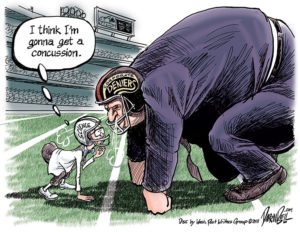17 September 2017 (Serifos, Greece) – Frankly, I never saw the fascination with American football. I have never been a fan, even as a kid. I always saw it as the NFL/collegiate powers’ mercenary marriage of patriotism, military, violence and unquestioned loyalty. With its military-like strategy on the field and its culture of conflict and male solidarity.
It’s an American “cultural thing” that permeates living rooms and language, and even the holidays. I have never seen it as a “sport”. Too much religious, quasi messianic tonalities, resonant with awe, horror, and excess.
But I really lost interest when the media stories continued to proliferate about university football players escaping punishment for proven sexual assaults by universities fearful of losing alumni funding, and the brain scans that were (finally) exposed that showed what many knew or suspected : the lingering brain damage in high school and college football players.
But hey, that’s just me. I have not watched a game in over 20 years. Probably been in Europe for too long. Maybe I am missing something.
The NFL got its own session at Cannes Lions this year. As we learned, and as Bloomberg recently reported, the NFL experienced 13% drop in viewers for its Thursday night opener, and declines on its Sunday broadcasts on CBS and Fox.
The NFL wants to double its revenues by 2025, so this is a troubling trend. In 2016, the league blamed the presidential election for its lower ratings. This year, the scapegoat is Hurricane Irma news. But such justifications mask a more troubling possibility: Interest in the NFL has peaked and shrinking viewership is the new norm.
Watching football games on TV, to the NFL’s credit, got noticeably better this year. Games get four commercial breaks in each quarter instead of five, and a “double box” split-screen shows ads on one side and replays on the other. As a result, most of last weekend’s games took less than three hours.
Still, consider what else is chipping away at football’s popularity. Some fans are turned off by players who are using their visibility during the national anthem to protest social injustice. Other fans are tuning out due to the possibility the league blackballed the first player to do so, former 49ers quarterback Colin Kaepernick. Meanwhile the NFL keeps winding up in court fighting for its right to suspend players for on- and off-field misbehavior. The league has so alienated its players union over this issue, a strike is likely when their contract expires in 2021.
Those problems seem quaint next to the NFL’s primary existential threat: the near guarantee that football causes lasting brain damage. A headline-grabbing study of the brains of 111 deceased NFL players found signs of CTE, a degenerative brain condition brought on by repeated strikes to the head, in 110 of them.
NOTE: Chronic traumatic encephalopathy, a degenerative brain disease linked to repetitive head trauma, was first revealed in football players. Since the initial discovery of the disease and what it does to the brain scientists have discovered that linebackers, who engage in a series of smaller collisions during every play, do worse than other players who may take harder, but fewer hits during the average game. But football is not the only contact sport where repeated head trauma is common. Neurologists are stating the trauma sustained by soccer players may rival football’s impact on the brain. It does not matter how head contact/impact comes about, but that it is done repeatedly.
A handful of players have retired early citing concern for their brain health. Participation in high school football is down 2.5% this year. That’s to say nothing of the untold number of parents now steering younger kids into other sports. Fans, too, have begun to question the ethics of supporting a sport they know harms players.
And we haven’t even gotten to the issue of the quality of play. To reduce the opportunity for head blows, teams have limited practice time or eliminated full-contact practices entirely. But diminished preparation has been widely blamed for the poor quality of the games at the start of this season.
The NFL has its work cut out for it. It needs to grow ratings even as people watch less TV. It wants players to be community pillars without protesting injustice. And it wants to make a game more exciting even as we question whether anyone should be playing it at all.
And … it’s almost needless to say … the lawyers are all over this. Lawsuits are proliferating. The legal issue usually involved in many lawsuits of this nature is whether or not the team management/owners gave players sufficient warning to make informed choices about running the risk of head injuries. I spoke to several lawyers who specialise in this type of case and they all said the same thing: if you are in a situation where you feel you were not properly advised about the dangers of playing contact sports, seek legal counsel. Find out your rights and how to file a lawsuit if you wish to proceed in that manner. The National Football League Players Association is organising what might be a first ever legal conference to address these brain damage issues.
